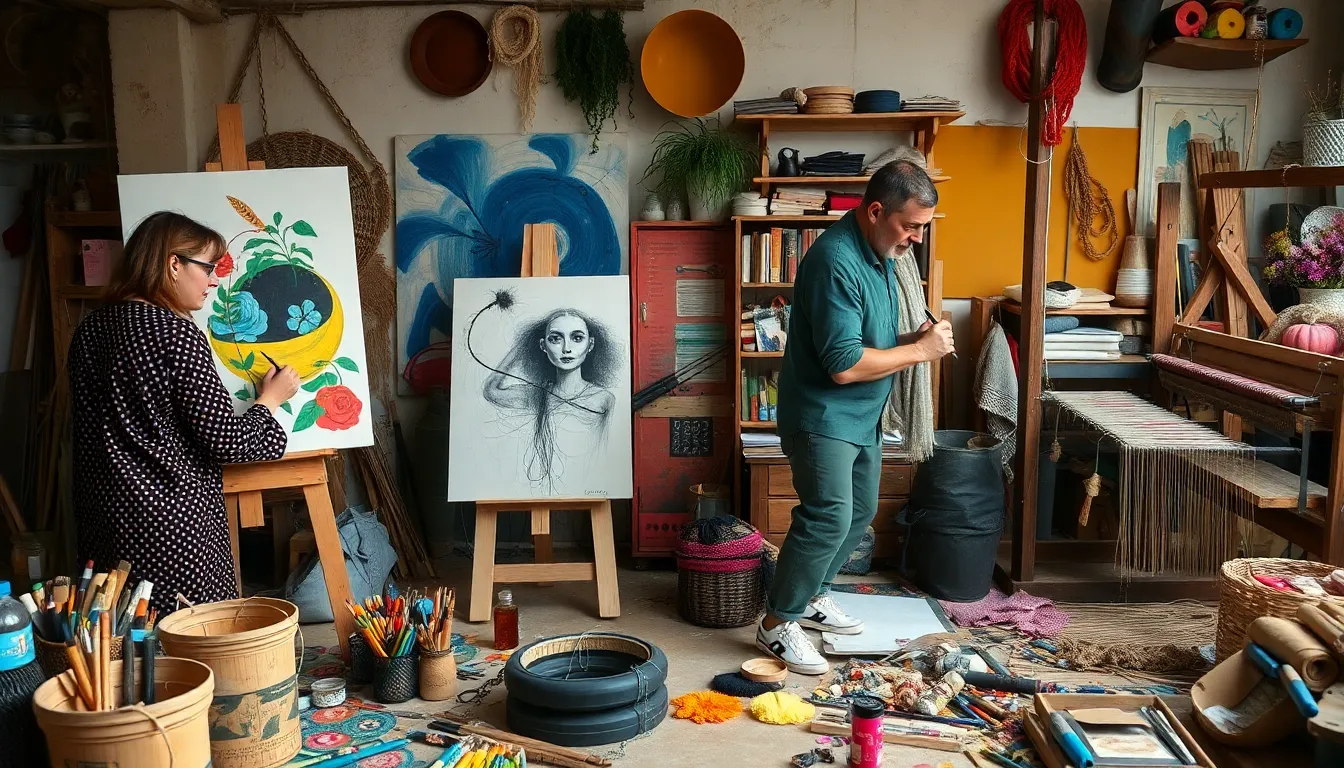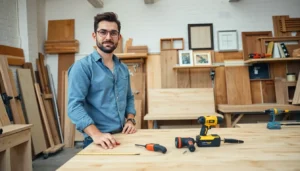In a world where self-expression often takes a backseat, expressive crafts offer a vibrant outlet for creativity. These hands-on activities allow individuals to channel their emotions into tangible creations, transforming thoughts and feelings into art. From painting to pottery, each craft serves as a unique medium for storytelling and personal exploration.
Engaging in expressive crafts not only fosters artistic skills but also promotes mental well-being. Whether it’s the soothing rhythm of knitting or the bold strokes of a paintbrush, these activities encourage mindfulness and provide a sense of accomplishment. As more people discover the therapeutic benefits of crafting, the movement continues to grow, inspiring a community of makers eager to share their journeys.
Table of Contents
ToggleWhat Are Expressive Crafts?
Expressive crafts encompass a variety of hands-on activities that foster creativity and allow individuals to communicate their feelings and experiences through artistic expression. These crafts include mediums such as painting, pottery, and textile arts, enabling participants to create unique pieces that reflect their personal narratives.
Definition and Characteristics
Expressive crafts focus on the process of creation rather than solely on the final product. They promote self-expression, exploration, and emotional release. Key characteristics include:
- Hands-on Engagement: Participants physically interact with materials, fostering a tangible connection to their emotions.
- Creative Freedom: There are no strict rules; techniques and styles flourish based on individual preferences.
- Personal Reflection: Crafting offers opportunities for introspection, allowing individuals to process thoughts and feelings.
- Diverse Mediums: Various materials, including clay, paint, fabric, and paper, facilitate diverse forms of artistic expression.
Importance in Art and Therapy
Expressive crafts hold significant value in both artistic communities and therapeutic settings. Their benefits include:
- Emotional Healing: Engaging in creative activities helps individuals communicate complex emotions and experiences.
- Mindfulness Practice: Crafts encourage focus and presence, promoting mental clarity and reducing stress.
- Community Building: Crafting fosters connections among individuals, creating supportive environments for sharing experiences.
- Cognitive Development: Hands-on activities stimulate critical thinking and problem-solving skills through experimentation and innovation.
By integrating expressive crafts into daily life, individuals can enhance their wellbeing and cultivate lasting connections to their creativity.
Types of Expressive Crafts

Expressive crafts encompass a range of activities that allow for personal interpretation and creativity. Each type serves as a unique outlet for emotions and ideas.
Visual Arts
Visual arts include two-dimensional and three-dimensional creations, engaging artists through mediums like painting, drawing, and sculpting.
- Painting: This craft utilizes color and form to convey emotions, offering techniques such as watercolors and acrylics. Many artists find liberation in experimenting with various styles, from abstract to realism.
- Drawing: Artists express their thoughts through pencil, charcoal, or ink, capturing details and narratives. This medium provides a foundation for exploring textures and perspectives.
- Sculpting: Sculptors manipulate materials such as clay, wood, or metal to create three-dimensional forms. This tactile involvement fosters a deep connection to the work and the emotions represented.
Textile Arts
Textile arts showcase creativity through fiber, fabric, and stitching. This category emphasizes both functional items and artistic expressions.
- Weaving: This craft involves interlacing threads to create everything from textiles to intricate wall hangings. Weavers engage with patterns and colors, making each piece unique.
- Embroidery: Through stitching patterns or images onto fabric, artists personalize their creations, adding depth and texture. This activity promotes mindfulness and attention to detail.
- Quilting: Quirky and colorful fabrics combine in quilts, often telling a story through design. This collaborative craft encourages community interaction, with many groups coming together to create larger pieces.
Mixed Media
Mixed media combines different materials and techniques, pushing the boundaries of traditional art forms. This craft embraces experimentation and innovation.
- Collage: Artists assemble various elements, such as photographs, paper, and fabric, to create a vibrant visual narrative. Collage invites playfulness and personal expression.
- Assemblage: This three-dimensional art form combines found objects and materials into cohesive sculptures, encouraging artists to explore the beauty in everyday items.
- Digital Art: Using software, artists create visual compositions that blend traditional techniques with technology. This evolving medium allows for limitless creativity and easy sharing across digital platforms.
Benefits of Engaging in Expressive Crafts
Engaging in expressive crafts offers numerous benefits that significantly impact emotional and creative well-being. These crafts serve as powerful tools for emotional release, enhance individual creativity, and foster personal expression.
Emotional Release and Healing
Expressive crafts facilitate emotional release by providing a safe space for individuals to process feelings. Crafting activities like painting or sculpting channel emotions into tangible forms, promoting a deeper understanding of one’s emotional landscape. Research has shown that engaging in creative activities reduces anxiety and stress levels, contributing to improved mental health. Participants report feelings of relief and satisfaction after expressing their emotions through art, indicating a connection between creativity and emotional healing. Engaging in these crafts allows individuals to confront and cope with challenges, fostering resilience and personal growth.
Enhancing Creativity and Self-Expression
Engaging in expressive crafts significantly enhances creativity and self-expression. Crafts such as drawing, quilting, or mixed media enable individuals to experiment with colors, textures, and forms, allowing self-discovery and artistic exploration. The creative process encourages divergent thinking, which promotes innovative ideas and problem-solving skills. As individuals explore different materials and techniques, they develop a unique artistic voice that reflects their experiences and perspectives. This creative freedom encourages individuals to articulate their thoughts and feelings in ways that traditional communication may not allow, strengthening their overall sense of identity and personal fulfillment.
How to Get Started with Expressive Crafts
Starting with expressive crafts involves selecting a craft that resonates with individual interests and gathering the necessary materials. With this foundation, participants can freely explore their creativity and emotions.
Choosing the Right Craft for You
Selecting the right craft depends on personal interests, available time, and desired outcomes. Consider the following factors when making a choice:
- Interest Level: Identify crafts that spark excitement. Painting, pottery, or textile arts can provide diverse ways to express feelings.
- Skill Development: Choose crafts that match existing skills or challenge individuals to learn new techniques. Beginners may prefer simple activities like drawing or collage.
- Time Commitment: Assess how much time can be dedicated. Quick crafts, like sketching, offer immediate satisfaction, while projects like pottery may require more planning.
- Available Space: Evaluate workspace availability. Some crafts, like knitting or digital art, need minimal space, while others, such as sculpting, might need ample room.
Essential Tools and Materials
Gathering the right tools and materials ensures a smooth creative process. Common supplies vary by craft type, but typical essentials include:
- Sketchbooks and Pencils: Ideal for drawing and visual arts, allowing for easy brainstorming and experimentation.
- Paints and Brushes: A variety of paints, such as acrylic or watercolor, enable diverse techniques and styles in visual arts.
- Textiles and Threads: For textile arts, fabrics, threads, and needles create the foundation for projects like embroidery and quilting.
- Adhesives and Substrates: Mixed media projects require glue, scissors, and various materials, such as paper, fabric, and found objects, to enhance creativity.
By thoughtfully selecting a craft and preparing the necessary materials, individuals embark on a fulfilling journey through expressive crafts.
Expressive crafts offer a powerful avenue for individuals to connect with their emotions and unleash their creativity. By engaging in various hands-on activities, people can find joy and fulfillment while enhancing their mental well-being. The sense of community that emerges from sharing these experiences further enriches the journey, fostering connections among makers.
As individuals explore the diverse world of expressive crafts, they pave the way for personal growth and self-discovery. Embracing these creative outlets not only nurtures artistic expression but also promotes healing and mindfulness. With the right approach and materials, anyone can embark on a transformative crafting journey that celebrates their unique voice and experiences.


